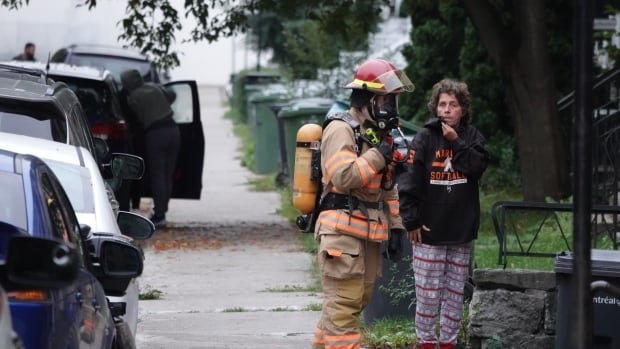A lithium battery fire sent toxic gas over Montreal. Are we ready for such emergencies?

Residents, chemists and firefighters are raising concerns about prevention and emergency preparedness after 15,000 kilograms of lithium batteries inside a shipping container caught fire at the Port of Montreal on Monday.
“Around 6 p.m., I started smelling something chemical in my place,” said Lia Chauvel, who lives about two kilometres from the port. “Like at 7 p.m., I get a text from the city. I thought it was spam.”
The fire started at 2:40 p.m. About two hours later, the city issued a precautionary lockdown notice through landlines to some nearby residents. A reminder alert was sent at 6:51 p.m.
At 6:53 p.m., the Mercier—Hochelaga-Maisonneuve borough posted a warning on Facebook, and the comment section quickly filled with residents saying they were never notified or didn’t see the post until much later.
Meanwhile, about 100 people were evacuated from the area near the fire, but there was no mandatory evacuation order, according to city spokesperson Camille Bégin.
The Montreal fire department says there’s been 40 of these fires so far this year, including a major fire at the Port of Montreal. In 2021, there were fewer than 10 in the city.
“Residents were free to leave or stay and were offered transportation to a safe location while awaiting confirmation that the fire posed no danger,” she said.
But it wasn’t just the fire that worried experts. Lithium battery fires emit hazardous pollutants like hydrogen fluoride and small particles that can penetrate the lungs, said McGill University epidemiology professor Jill Baumgartner.
Montreal firefighters were seen wearing self-contained breathing apparatuses as they went out into the neighbourhood, urging people to shelter in place or leave the area.
Residents, on the other hand, had nothing covering their eyes, noses and mouths.
Health risks possible, expert says
Exposure to high levels of hydrogen fluoride can cause chemical burns, eye irritation and respiratory distress, Baumgartner said.
Acute exposure can even lead to a risk of heart attack or stroke, she said. Health risks depend on the length of exposure, pollutant concentrations and individual vulnerability.
“Residents living close to where the fire occurred, firefighters and first responders may want to monitor their health over the next week, though the greatest health risks from exposure to pollutants like hydrogen fluoride are likely soon after exposure occurs,” said Baumgartner.

Quebec does have a phone alert system, but Bégin said the city had no confirmation of any imminent danger. The alert system also casts too wide a net, making it a suboptimal solution, she said.
The city has an action plan in place that is designed to ensure effective management of emergencies and disruptions by co-ordinating resources, protecting the population and maintaining essential services during a crisis. That plan was activated, Bégin said.
She said continuous updates were provided by the borough and city, including social media posts, advisories and alerts, until the shelter-in-place advisory was lifted at 9:30 p.m.
Fire department division chief worries for future
Martin Guilbault, division chief with the Montreal fire department, said the lithium batteries entered thermal runaway, which required firefighters to cool the container for hours, aided by a special drill from airport colleagues.
Guilbault said this was a first in his 32-year career, and he suspects this isn’t the last large-scale lithium battery fire.
“I would say that every fire department on the planet is concerned about that,” he said.
The construction of a $7-billion electric vehicle battery plant is planned for Montreal’s South Shore. And according to Quebec government targets, two million electric vehicles will be on the roads by 2030. Batteries, be they in our pockets, bikes or cars, are everywhere now.

Eric McCalla, a McGill University chemistry professor, said this latest incident raises questions about how lithium batteries are stored and transported.
“We’re not used to fighting these fires, so there’s a lot of know-how that’s going to have to be developed,” McCalla said.
McCalla said manufacturers and shipping companies take precautions, and if a lithium battery catches fire, it’s not supposed to spread to others unless something went wrong.
“It’s something that doesn’t happen very often, so the regulations have not kept up,” he said. “But I think we’re starting to see what’s going to need to happen as we go towards more and more electric vehicles.”
Pushing for regulation changes
Randy Narine is among those who have been pushing for stricter regulations on transportation and storage of lithium batteries.
He is an Ontario-based firefighter and lithium-ion researcher with the Clean Energy Safety and Training Council of Canada, an organization dedicated to providing training and research to front-line workers and first responders in the clean energy sector.
“When these things go into thermal runaway, you are emitting a lot of hazardous chemicals,” said Narine. “It’s understanding how to mitigate those chemicals that is going to protect the general public.”
Watching the incident unfold in Montreal, he was immediately concerned for residents who were breathing in the fumes and said they should have all been evacuated. He said people may have minor symptoms, but not realize how bad the damage is to their body.
First responders were seen warning residents in neighbourhoods near the Port of Montreal to do what they can to avoid inhaling smoke from a burning shipping container of lithium batteries.
This is why he wants the government to ensure lithium batteries are stored in a way that prevents fire from spreading.
He questioned what would have happened if the shipping container, filled with lithium batteries, had been loaded on a truck and driven into downtown Montreal. Internal pressure from the fire could even cause the container to explode, he said.
“It’s the micro-mobility devices that are kept in bulk in a store. It’s the car batteries kept in bulk in a factory. It’s the car batteries shipping in these containers in bulk. These are the problems,” said Narine.
There are solutions such as casing that separates each unit to prevent fires from spreading between batteries, but right now he said there “is no standard in the transportation world.”
Even though what occurred in Montreal is rare, Canada needs preventive regulations and proper emergency response tools in place to battle these types of fires, he said.
The Quebec order of chemists wants the province to give it a bigger role when it comes to prevention.
The Port of Montreal said in a statement that it took all the necessary precautions and it has teams in place to respond to emergencies. It’s waiting for the impending investigation before making any changes.
In a statement, Quebec’s Ministry of Public Security (MSP) says there are federal, provincial and, in some cases, municipal regulations in place when it comes to the transportation and storage of lithium batteries.
The ministry and Quebec’s firefighter school have developed initiatives to improve firefighters’ response to lithium-ion battery fires and provide prevention tools for citizens. And fire services are kept updated on best practices for these types of incidents, the statement says.
The government has an all-hazards preparedness plan to support municipalities and encourages a risk-management approach for all organizations, it says.
“The MSP is also in contact with standardization organizations to monitor standards related to the fire risks involving this type of battery,” it says.
Source link




